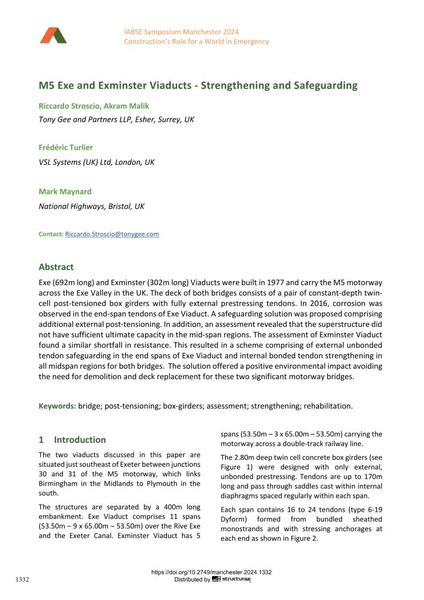M5 Exe and Exminster Viaducts - Strengthening and Safeguarding

|
|
|||||||||||
Bibliografische Angaben
| Autor(en): |
Riccardo Stroscio
(Tony Gee and Partners LLP, Esher, Surrey, UK)
Akram Malik (Tony Gee and Partners LLP, Esher, Surrey, UK) Frédéric Turlier (VSL Systems (UK) Ltd, London, UK) Mark Maynard (National Highways, Bristol, UK) |
||||
|---|---|---|---|---|---|
| Medium: | Tagungsbeitrag | ||||
| Sprache(n): | Englisch | ||||
| Tagung: | IABSE Symposium: Construction’s Role for a World in Emergency, Manchester, United Kingdom, 10-14 April 2024 | ||||
| Veröffentlicht in: | IABSE Symposium Manchester 2024 | ||||
|
|||||
| Seite(n): | 1332-1339 | ||||
| Anzahl der Seiten (im PDF): | 8 | ||||
| DOI: | 10.2749/manchester.2024.1332 | ||||
| Abstrakt: |
Exe (692m long) and Exminster (302m long) Viaducts were built in 1977 and carry the M5 motorway across the Exe Valley in the UK. The deck of both bridges consists of a pair of constant-depth twin- cell post-tensioned box girders with fully external prestressing tendons. In 2016, corrosion was observed in the end-span tendons of Exe Viaduct. A safeguarding solution was proposed comprising additional external post-tensioning. In addition, an assessment revealed that the superstructure did not have sufficient ultimate capacity in the mid-span regions. The assessment of Exminster Viaduct found a similar shortfall in resistance. This resulted in a scheme comprising of external unbonded tendon safeguarding in the end spans of Exe Viaduct and internal bonded tendon strengthening in all midspan regions for both bridges. The solution offered a positive environmental impact avoiding the need for demolition and deck replacement for these two significant motorway bridges. |
||||
| Stichwörter: |
Brücke Verstärkung Instandsetzung Bewertung
|
||||
